Full Stack Developer Resume Examples

Aug 27, 2024
|
12 min read
Nail your full stack developer resume: showcasing your "stacked" skills from front-end to back-end development in a way that impresses hiring managers. Highlight your expertise and get the job you want.
Rated by 348 people
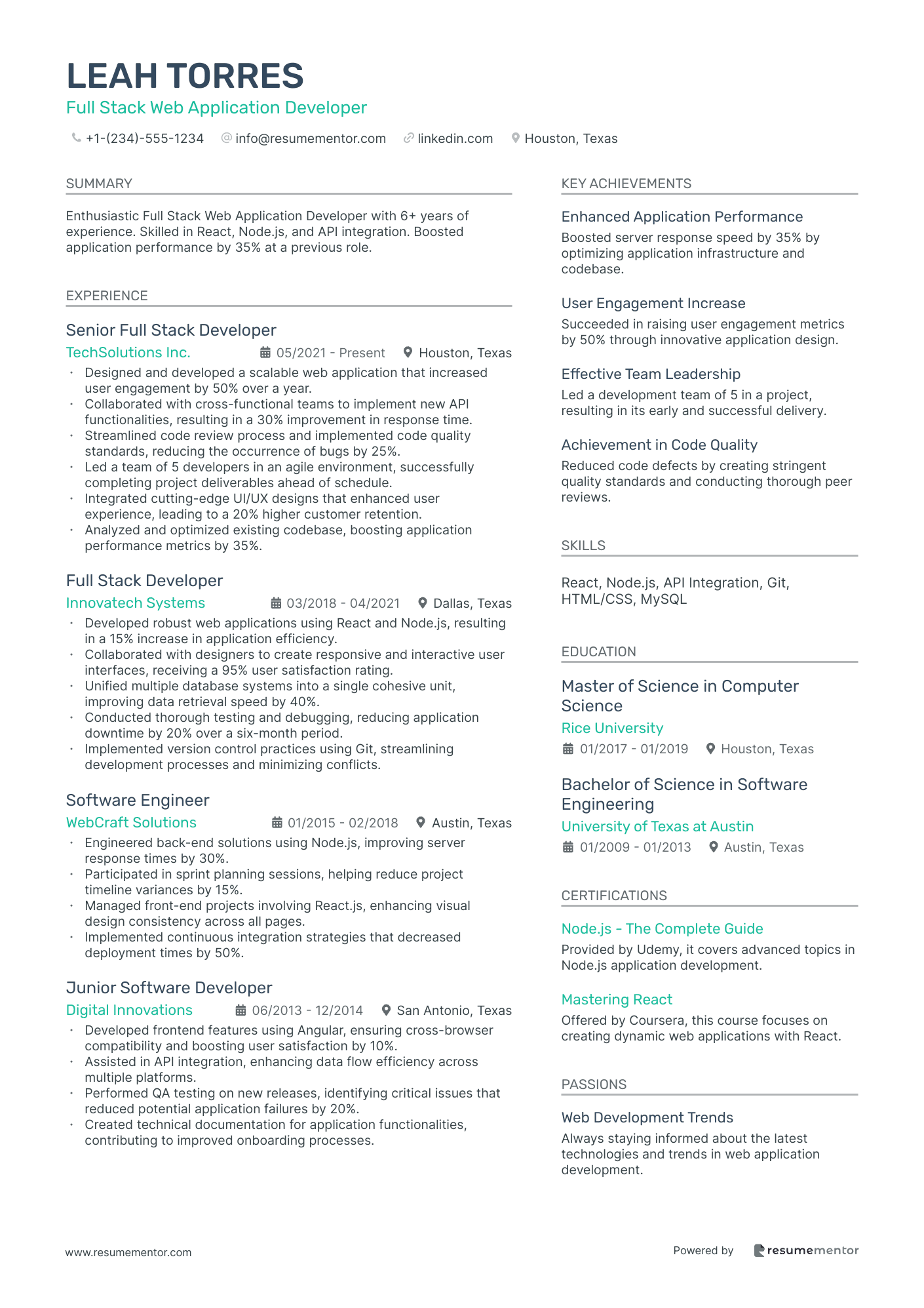
Full Stack Web Application Developer
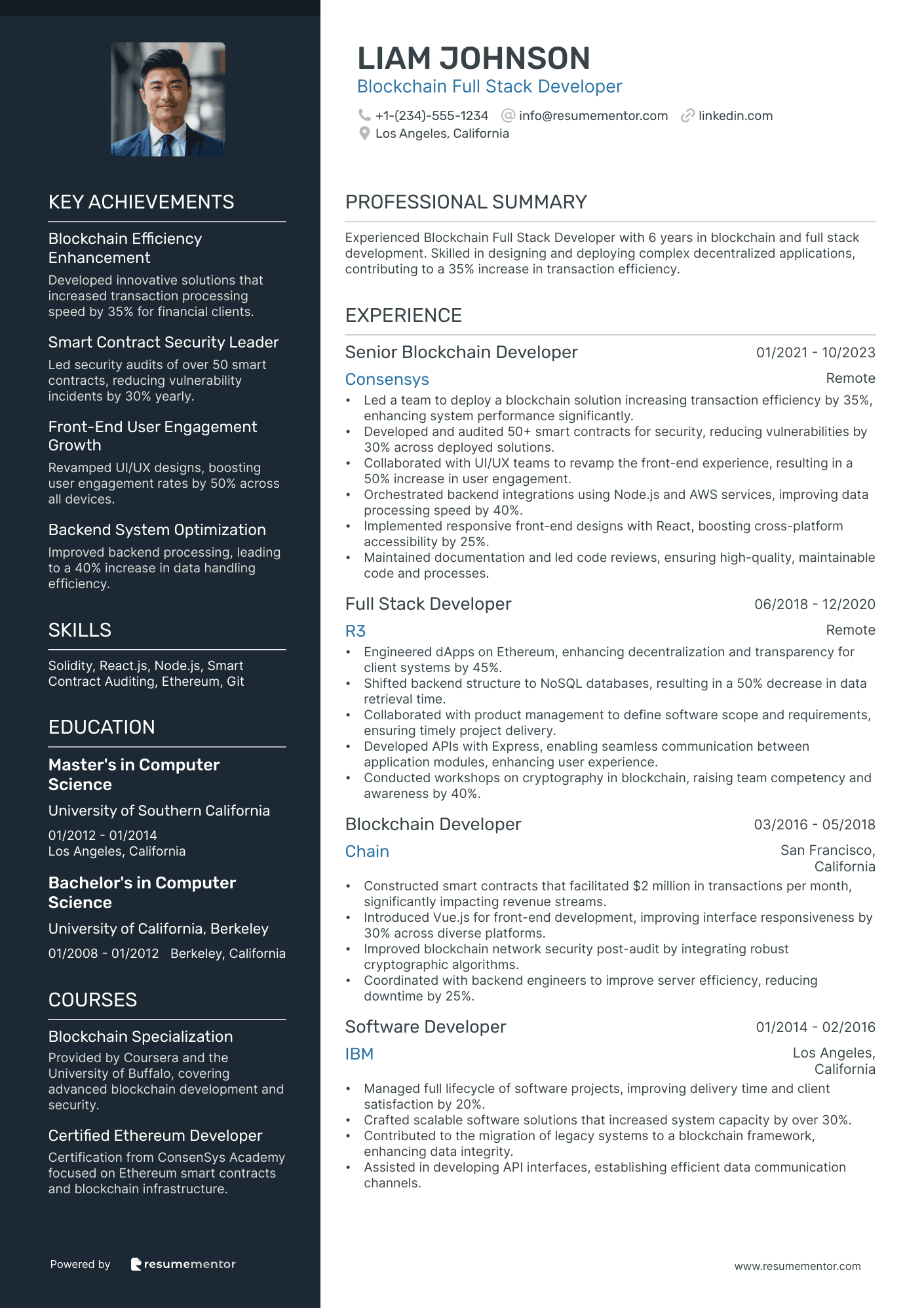
Blockchain Full Stack Developer
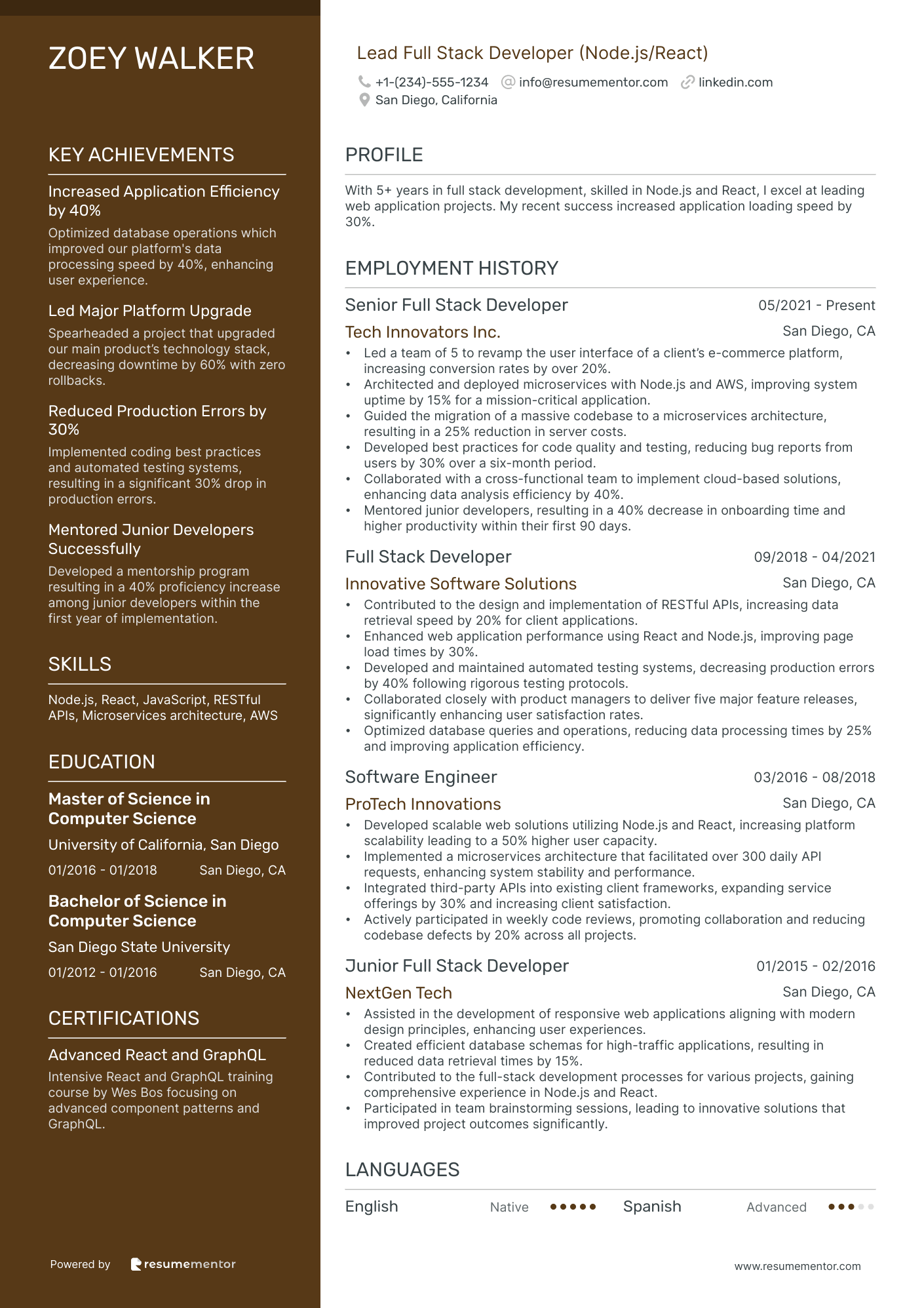
Lead Full Stack Developer (Node.js/React)
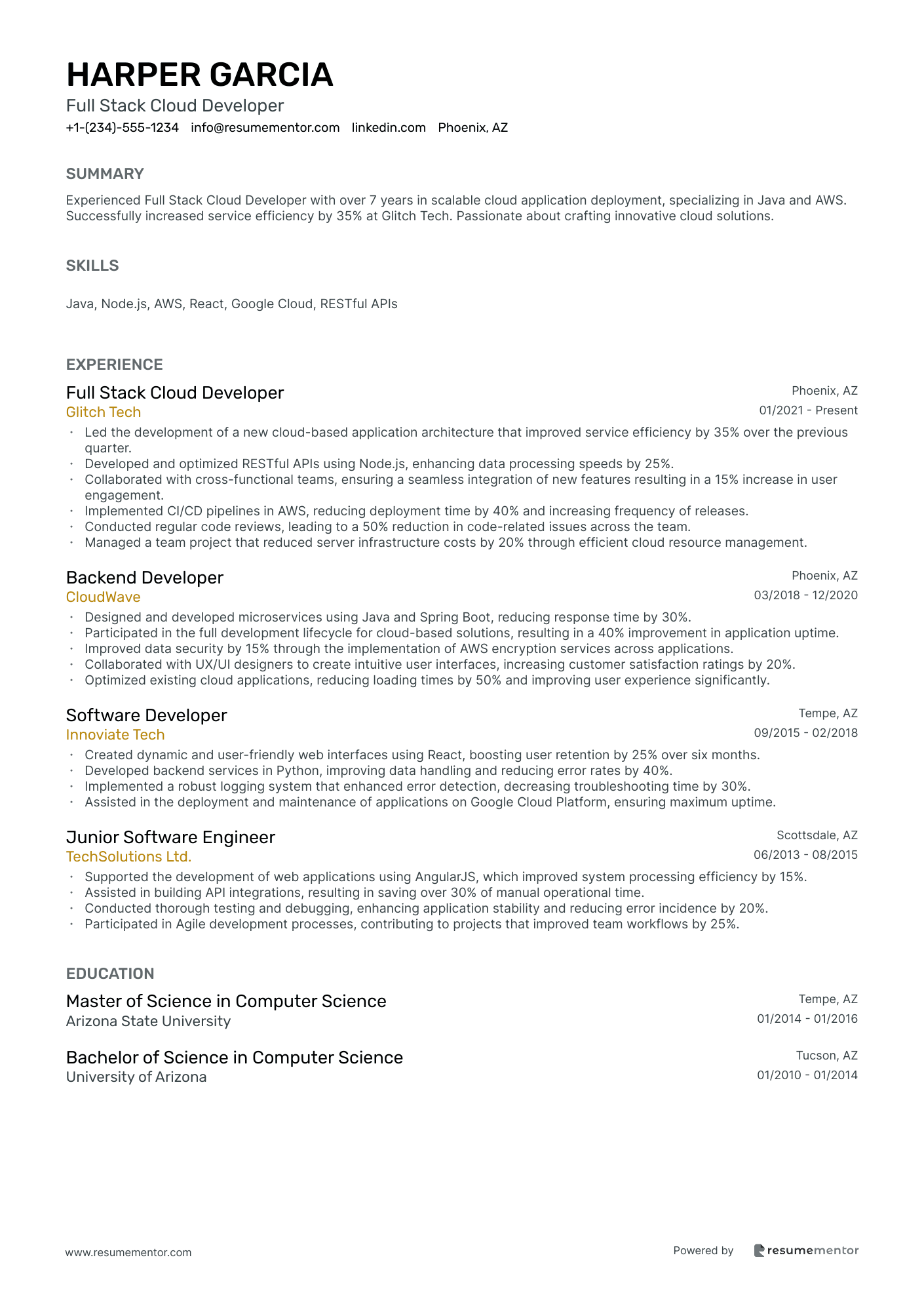
Full Stack Cloud Developer
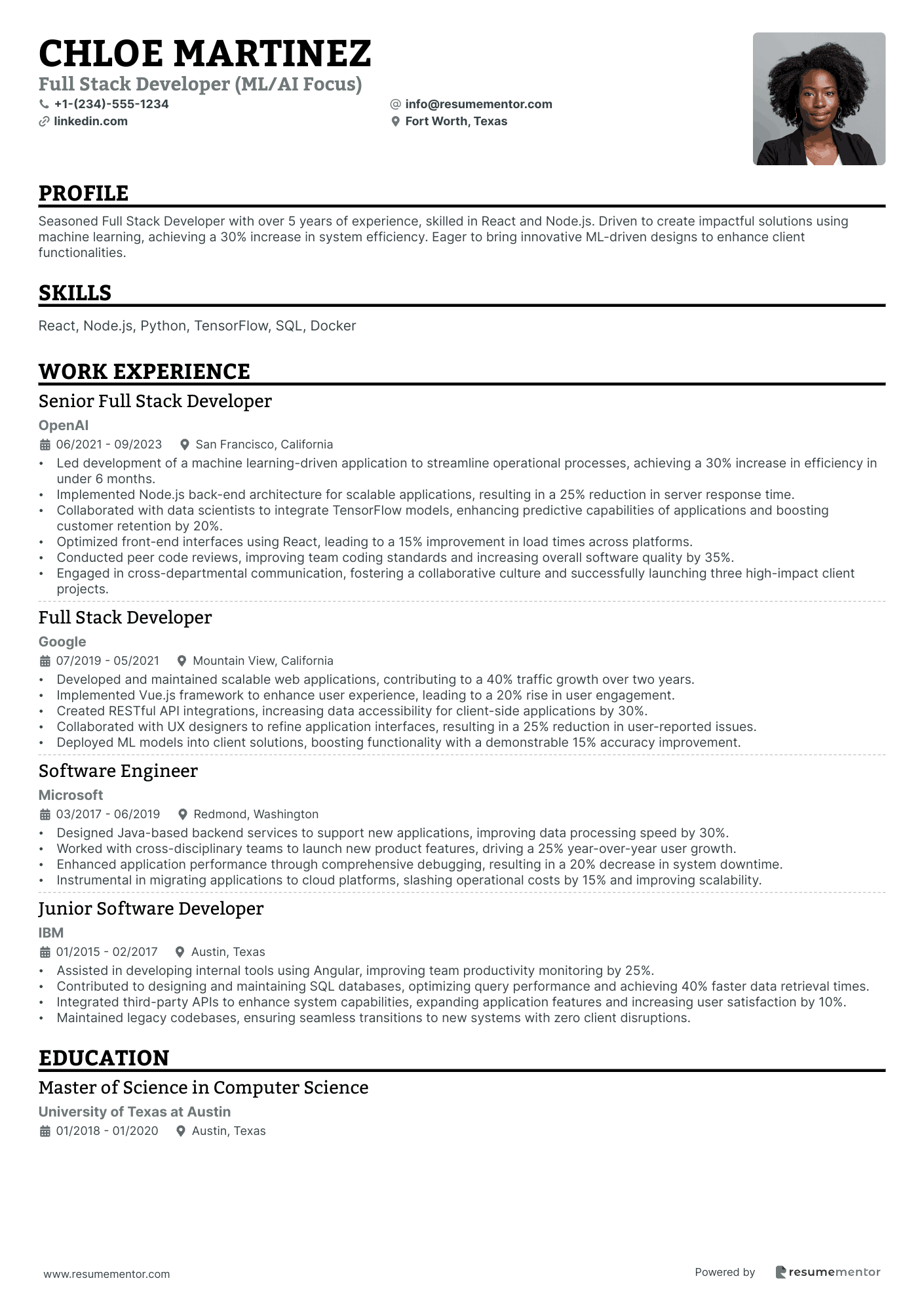
Full Stack Developer (ML/AI focus)
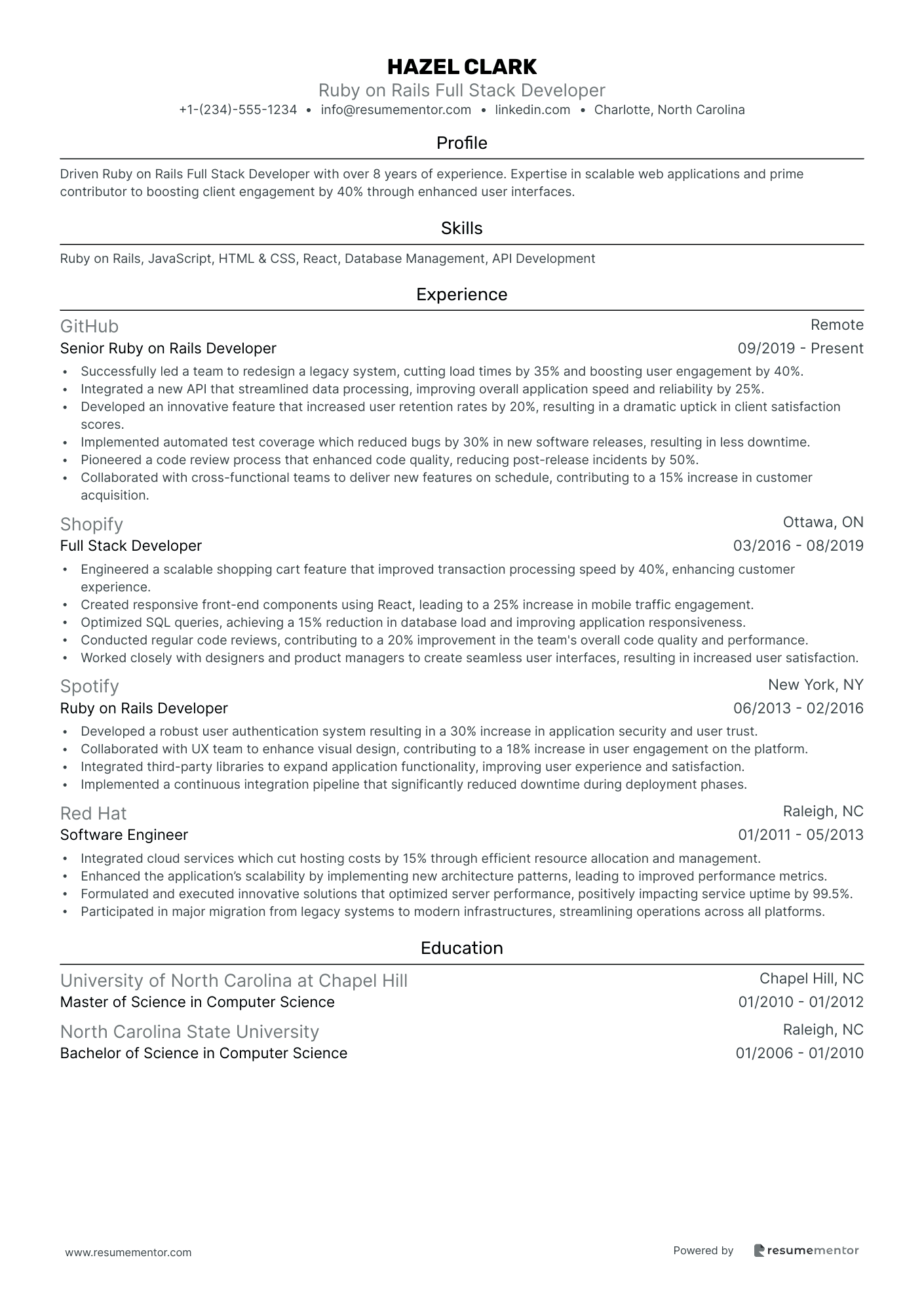
Ruby on Rails Full Stack Developer
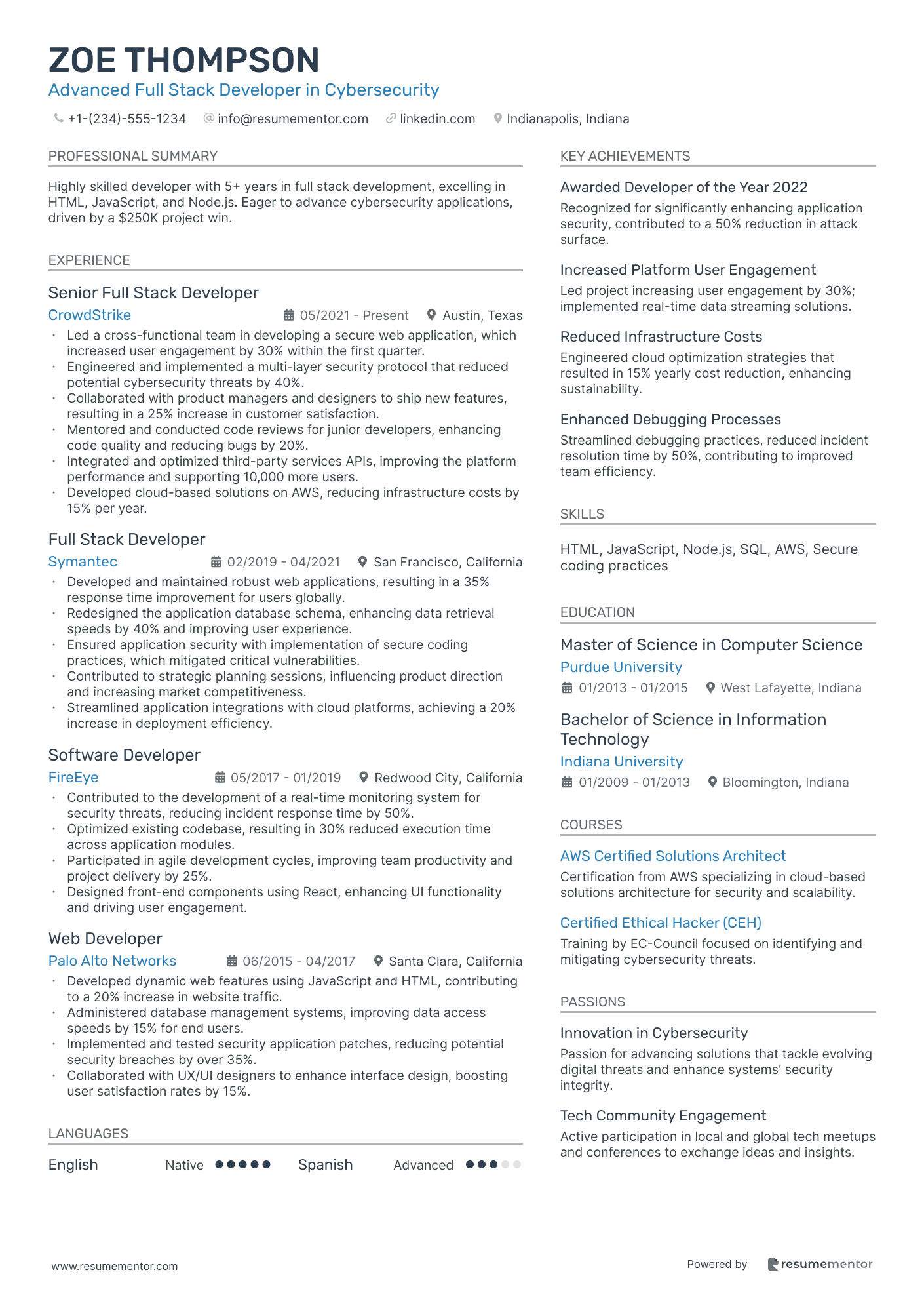
Advanced Full Stack Developer in Cybersecurity
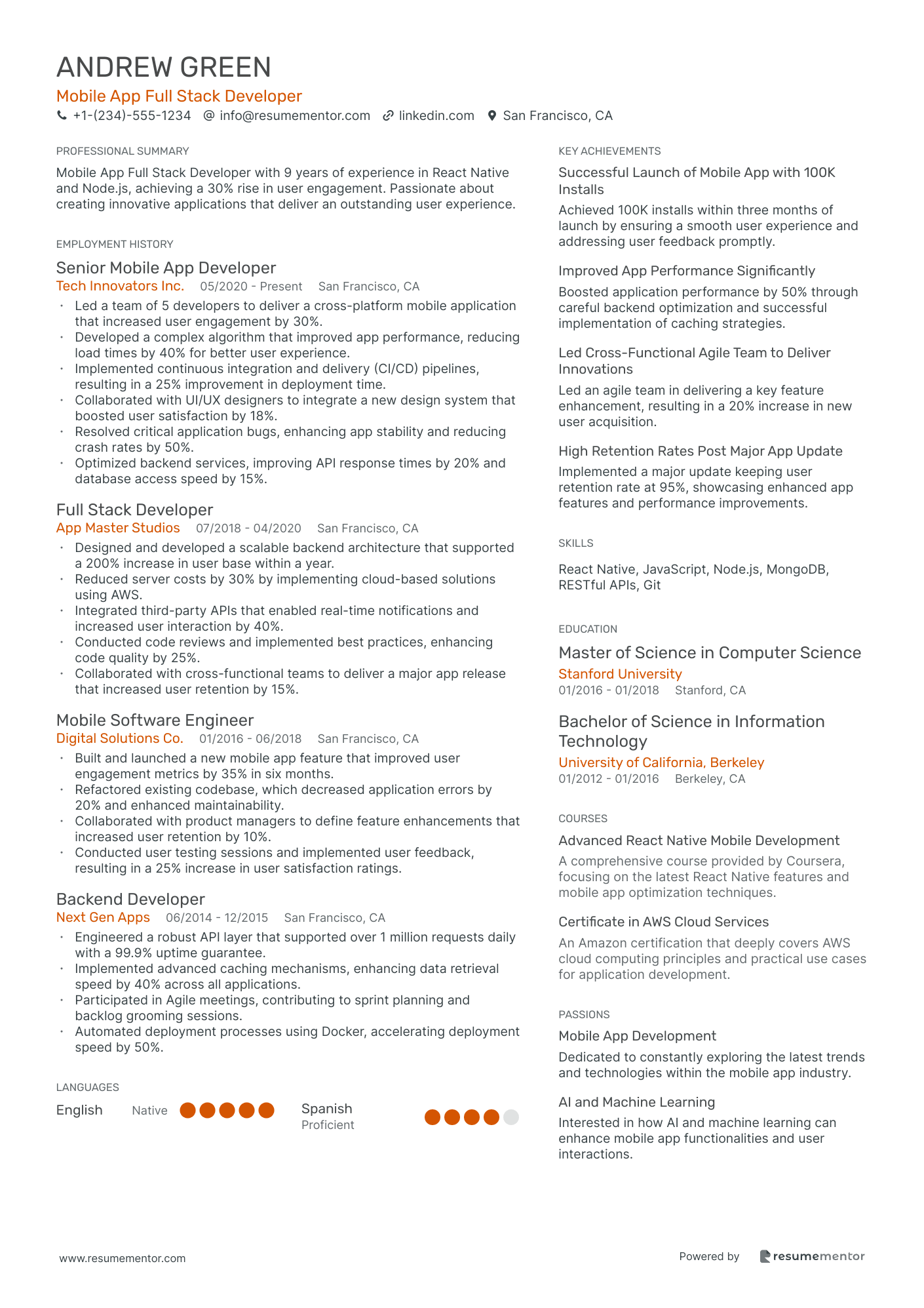
Mobile App Full Stack Developer
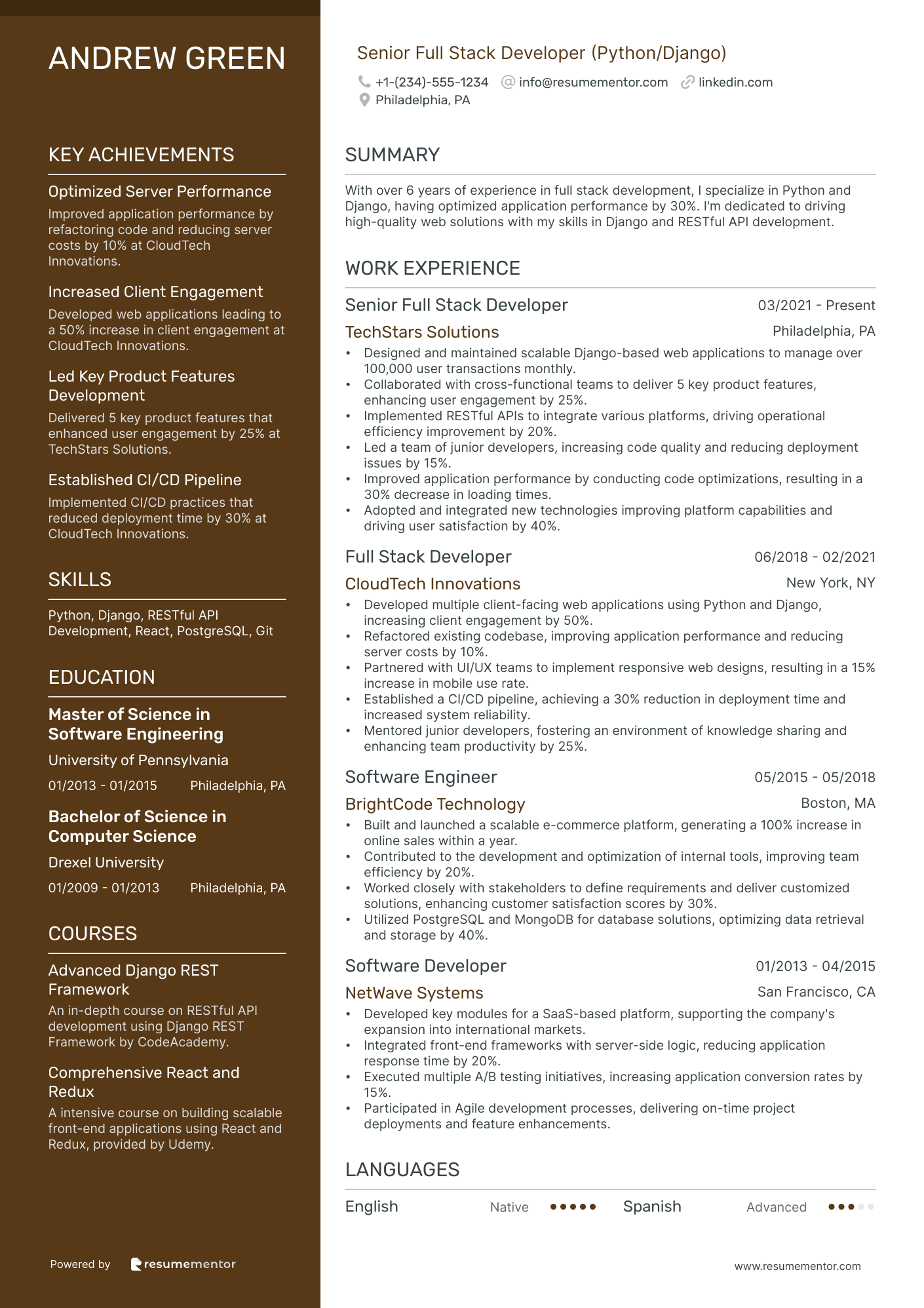
Senior Full Stack Developer (Python/Django)
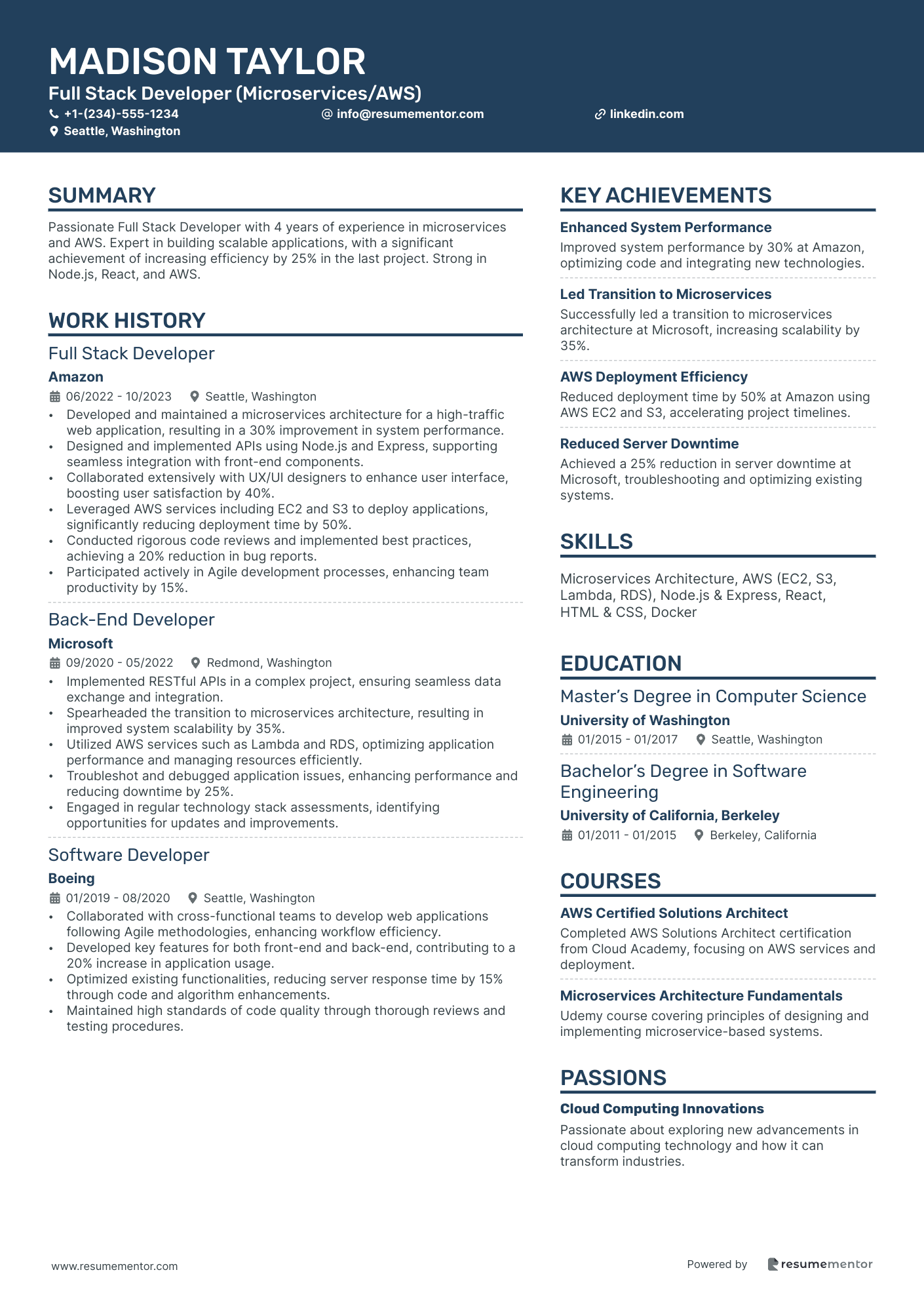
Full Stack Developer (Microservices/AWS)
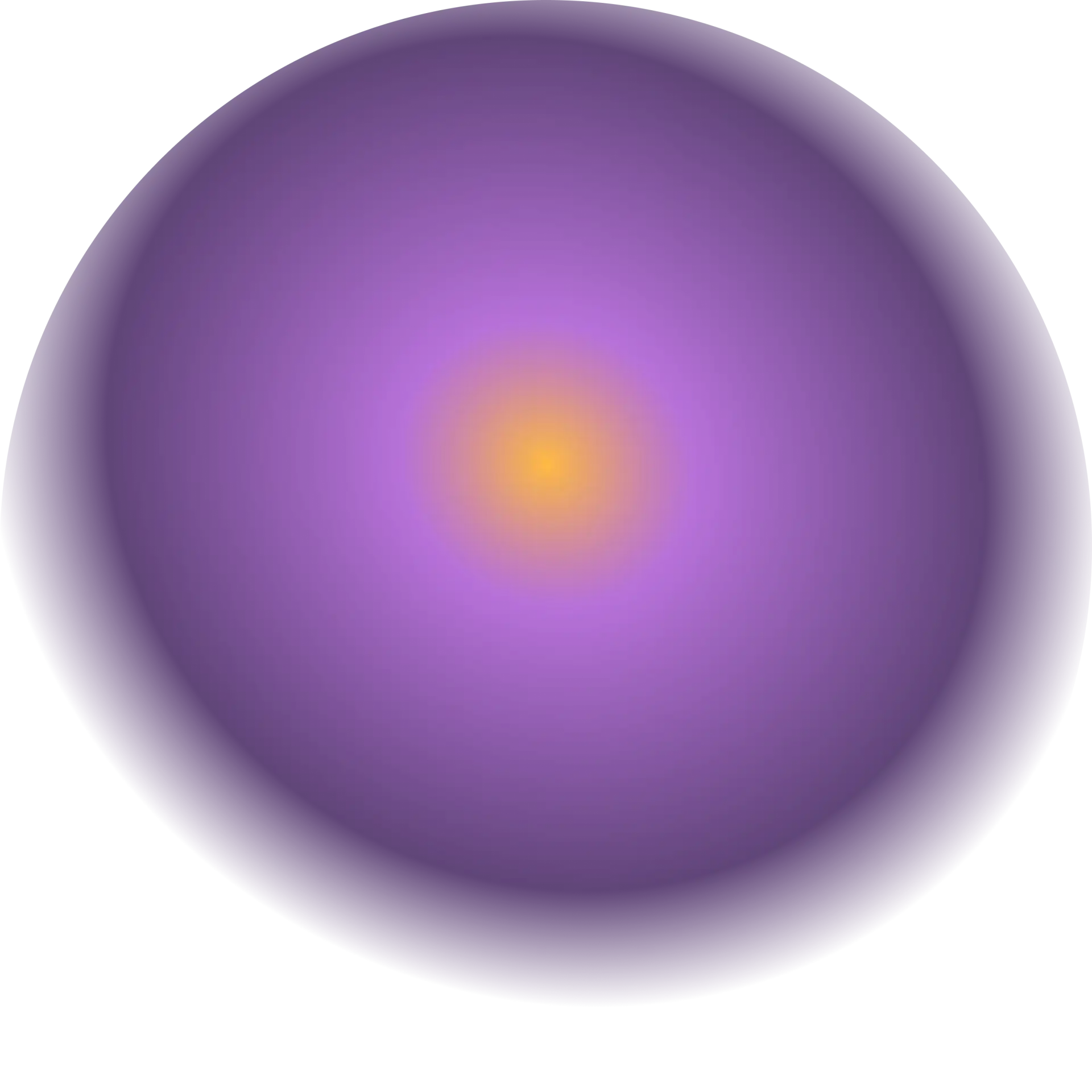
Full Stack Web Application Developer resume sample
- •Designed and developed a scalable web application that increased user engagement by 50% over a year.
- •Collaborated with cross-functional teams to implement new API functionalities, resulting in a 30% improvement in response time.
- •Streamlined code review process and implemented code quality standards, reducing the occurrence of bugs by 25%.
- •Led a team of 5 developers in an agile environment, successfully completing project deliverables ahead of schedule.
- •Integrated cutting-edge UI/UX designs that enhanced user experience, leading to a 20% higher customer retention.
- •Analyzed and optimized existing codebase, boosting application performance metrics by 35%.
- •Developed robust web applications using React and Node.js, resulting in a 15% increase in application efficiency.
- •Collaborated with designers to create responsive and interactive user interfaces, receiving a 95% user satisfaction rating.
- •Unified multiple database systems into a single cohesive unit, improving data retrieval speed by 40%.
- •Conducted thorough testing and debugging, reducing application downtime by 20% over a six-month period.
- •Implemented version control practices using Git, streamlining development processes and minimizing conflicts.
- •Engineered back-end solutions using Node.js, improving server response times by 30%.
- •Participated in sprint planning sessions, helping reduce project timeline variances by 15%.
- •Managed front-end projects involving React.js, enhancing visual design consistency across all pages.
- •Implemented continuous integration strategies that decreased deployment times by 50%.
- •Developed frontend features using Angular, ensuring cross-browser compatibility and boosting user satisfaction by 10%.
- •Assisted in API integration, enhancing data flow efficiency across multiple platforms.
- •Performed QA testing on new releases, identifying critical issues that reduced potential application failures by 20%.
- •Created technical documentation for application functionalities, contributing to improved onboarding processes.
Blockchain Full Stack Developer resume sample
- •Led a team to deploy a blockchain solution increasing transaction efficiency by 35%, enhancing system performance significantly.
- •Developed and audited 50+ smart contracts for security, reducing vulnerabilities by 30% across deployed solutions.
- •Collaborated with UI/UX teams to revamp the front-end experience, resulting in a 50% increase in user engagement.
- •Orchestrated backend integrations using Node.js and AWS services, improving data processing speed by 40%.
- •Implemented responsive front-end designs with React, boosting cross-platform accessibility by 25%.
- •Maintained documentation and led code reviews, ensuring high-quality, maintainable code and processes.
- •Engineered dApps on Ethereum, enhancing decentralization and transparency for client systems by 45%.
- •Shifted backend structure to NoSQL databases, resulting in a 50% decrease in data retrieval time.
- •Collaborated with product management to define software scope and requirements, ensuring timely project delivery.
- •Developed APIs with Express, enabling seamless communication between application modules, enhancing user experience.
- •Conducted workshops on cryptography in blockchain, raising team competency and awareness by 40%.
- •Constructed smart contracts that facilitated $2 million in transactions per month, significantly impacting revenue streams.
- •Introduced Vue.js for front-end development, improving interface responsiveness by 30% across diverse platforms.
- •Improved blockchain network security post-audit by integrating robust cryptographic algorithms.
- •Coordinated with backend engineers to improve server efficiency, reducing downtime by 25%.
- •Managed full lifecycle of software projects, improving delivery time and client satisfaction by 20%.
- •Crafted scalable software solutions that increased system capacity by over 30%.
- •Contributed to the migration of legacy systems to a blockchain framework, enhancing data integrity.
- •Assisted in developing API interfaces, establishing efficient data communication channels.
Lead Full Stack Developer (Node.js/React) resume sample
- •Led a team of 5 to revamp the user interface of a client’s e-commerce platform, increasing conversion rates by over 20%.
- •Architected and deployed microservices with Node.js and AWS, improving system uptime by 15% for a mission-critical application.
- •Guided the migration of a massive codebase to a microservices architecture, resulting in a 25% reduction in server costs.
- •Developed best practices for code quality and testing, reducing bug reports from users by 30% over a six-month period.
- •Collaborated with a cross-functional team to implement cloud-based solutions, enhancing data analysis efficiency by 40%.
- •Mentored junior developers, resulting in a 40% decrease in onboarding time and higher productivity within their first 90 days.
- •Contributed to the design and implementation of RESTful APIs, increasing data retrieval speed by 20% for client applications.
- •Enhanced web application performance using React and Node.js, improving page load times by 30%.
- •Developed and maintained automated testing systems, decreasing production errors by 40% following rigorous testing protocols.
- •Collaborated closely with product managers to deliver five major feature releases, significantly enhancing user satisfaction rates.
- •Optimized database queries and operations, reducing data processing times by 25% and improving application efficiency.
- •Developed scalable web solutions utilizing Node.js and React, increasing platform scalability leading to a 50% higher user capacity.
- •Implemented a microservices architecture that facilitated over 300 daily API requests, enhancing system stability and performance.
- •Integrated third-party APIs into existing client frameworks, expanding service offerings by 30% and increasing client satisfaction.
- •Actively participated in weekly code reviews, promoting collaboration and reducing codebase defects by 20% across all projects.
- •Assisted in the development of responsive web applications aligning with modern design principles, enhancing user experiences.
- •Created efficient database schemas for high-traffic applications, resulting in reduced data retrieval times by 15%.
- •Contributed to the full-stack development processes for various projects, gaining comprehensive experience in Node.js and React.
- •Participated in team brainstorming sessions, leading to innovative solutions that improved project outcomes significantly.
Full Stack Cloud Developer resume sample
- •Led the development of a new cloud-based application architecture that improved service efficiency by 35% over the previous quarter.
- •Developed and optimized RESTful APIs using Node.js, enhancing data processing speeds by 25%.
- •Collaborated with cross-functional teams, ensuring a seamless integration of new features resulting in a 15% increase in user engagement.
- •Implemented CI/CD pipelines in AWS, reducing deployment time by 40% and increasing frequency of releases.
- •Conducted regular code reviews, leading to a 50% reduction in code-related issues across the team.
- •Managed a team project that reduced server infrastructure costs by 20% through efficient cloud resource management.
- •Designed and developed microservices using Java and Spring Boot, reducing response time by 30%.
- •Participated in the full development lifecycle for cloud-based solutions, resulting in a 40% improvement in application uptime.
- •Improved data security by 15% through the implementation of AWS encryption services across applications.
- •Collaborated with UX/UI designers to create intuitive user interfaces, increasing customer satisfaction ratings by 20%.
- •Optimized existing cloud applications, reducing loading times by 50% and improving user experience significantly.
- •Created dynamic and user-friendly web interfaces using React, boosting user retention by 25% over six months.
- •Developed backend services in Python, improving data handling and reducing error rates by 40%.
- •Implemented a robust logging system that enhanced error detection, decreasing troubleshooting time by 30%.
- •Assisted in the deployment and maintenance of applications on Google Cloud Platform, ensuring maximum uptime.
- •Supported the development of web applications using AngularJS, which improved system processing efficiency by 15%.
- •Assisted in building API integrations, resulting in saving over 30% of manual operational time.
- •Conducted thorough testing and debugging, enhancing application stability and reducing error incidence by 20%.
- •Participated in Agile development processes, contributing to projects that improved team workflows by 25%.
Full Stack Developer (ML/AI focus) resume sample
- •Led development of a machine learning-driven application to streamline operational processes, achieving a 30% increase in efficiency in under 6 months.
- •Implemented Node.js back-end architecture for scalable applications, resulting in a 25% reduction in server response time.
- •Collaborated with data scientists to integrate TensorFlow models, enhancing predictive capabilities of applications and boosting customer retention by 20%.
- •Optimized front-end interfaces using React, leading to a 15% improvement in load times across platforms.
- •Conducted peer code reviews, improving team coding standards and increasing overall software quality by 35%.
- •Engaged in cross-departmental communication, fostering a collaborative culture and successfully launching three high-impact client projects.
- •Developed and maintained scalable web applications, contributing to a 40% traffic growth over two years.
- •Implemented Vue.js framework to enhance user experience, leading to a 20% rise in user engagement.
- •Created RESTful API integrations, increasing data accessibility for client-side applications by 30%.
- •Collaborated with UX designers to refine application interfaces, resulting in a 25% reduction in user-reported issues.
- •Deployed ML models into client solutions, boosting functionality with a demonstrable 15% accuracy improvement.
- •Designed Java-based backend services to support new applications, improving data processing speed by 30%.
- •Worked with cross-disciplinary teams to launch new product features, driving a 25% year-over-year user growth.
- •Enhanced application performance through comprehensive debugging, resulting in a 20% decrease in system downtime.
- •Instrumental in migrating applications to cloud platforms, slashing operational costs by 15% and improving scalability.
- •Assisted in developing internal tools using Angular, improving team productivity monitoring by 25%.
- •Contributed to designing and maintaining SQL databases, optimizing query performance and achieving 40% faster data retrieval times.
- •Integrated third-party APIs to enhance system capabilities, expanding application features and increasing user satisfaction by 10%.
- •Maintained legacy codebases, ensuring seamless transitions to new systems with zero client disruptions.
Ruby on Rails Full Stack Developer resume sample
- •Successfully led a team to redesign a legacy system, cutting load times by 35% and boosting user engagement by 40%.
- •Integrated a new API that streamlined data processing, improving overall application speed and reliability by 25%.
- •Developed an innovative feature that increased user retention rates by 20%, resulting in a dramatic uptick in client satisfaction scores.
- •Implemented automated test coverage which reduced bugs by 30% in new software releases, resulting in less downtime.
- •Pioneered a code review process that enhanced code quality, reducing post-release incidents by 50%.
- •Collaborated with cross-functional teams to deliver new features on schedule, contributing to a 15% increase in customer acquisition.
- •Engineered a scalable shopping cart feature that improved transaction processing speed by 40%, enhancing customer experience.
- •Created responsive front-end components using React, leading to a 25% increase in mobile traffic engagement.
- •Optimized SQL queries, achieving a 15% reduction in database load and improving application responsiveness.
- •Conducted regular code reviews, contributing to a 20% improvement in the team's overall code quality and performance.
- •Worked closely with designers and product managers to create seamless user interfaces, resulting in increased user satisfaction.
- •Developed a robust user authentication system resulting in a 30% increase in application security and user trust.
- •Collaborated with UX team to enhance visual design, contributing to a 18% increase in user engagement on the platform.
- •Integrated third-party libraries to expand application functionality, improving user experience and satisfaction.
- •Implemented a continuous integration pipeline that significantly reduced downtime during deployment phases.
- •Integrated cloud services which cut hosting costs by 15% through efficient resource allocation and management.
- •Enhanced the application’s scalability by implementing new architecture patterns, leading to improved performance metrics.
- •Formulated and executed innovative solutions that optimized server performance, positively impacting service uptime by 99.5%.
- •Participated in major migration from legacy systems to modern infrastructures, streamlining operations across all platforms.
Advanced Full Stack Developer in Cybersecurity resume sample
- •Led a cross-functional team in developing a secure web application, which increased user engagement by 30% within the first quarter.
- •Engineered and implemented a multi-layer security protocol that reduced potential cybersecurity threats by 40%.
- •Collaborated with product managers and designers to ship new features, resulting in a 25% increase in customer satisfaction.
- •Mentored and conducted code reviews for junior developers, enhancing code quality and reducing bugs by 20%.
- •Integrated and optimized third-party services APIs, improving the platform performance and supporting 10,000 more users.
- •Developed cloud-based solutions on AWS, reducing infrastructure costs by 15% per year.
- •Developed and maintained robust web applications, resulting in a 35% response time improvement for users globally.
- •Redesigned the application database schema, enhancing data retrieval speeds by 40% and improving user experience.
- •Ensured application security with implementation of secure coding practices, which mitigated critical vulnerabilities.
- •Contributed to strategic planning sessions, influencing product direction and increasing market competitiveness.
- •Streamlined application integrations with cloud platforms, achieving a 20% increase in deployment efficiency.
- •Contributed to the development of a real-time monitoring system for security threats, reducing incident response time by 50%.
- •Optimized existing codebase, resulting in 30% reduced execution time across application modules.
- •Participated in agile development cycles, improving team productivity and project delivery by 25%.
- •Designed front-end components using React, enhancing UI functionality and driving user engagement.
- •Developed dynamic web features using JavaScript and HTML, contributing to a 20% increase in website traffic.
- •Administered database management systems, improving data access speeds by 15% for end users.
- •Implemented and tested security application patches, reducing potential security breaches by over 35%.
- •Collaborated with UX/UI designers to enhance interface design, boosting user satisfaction rates by 15%.
Mobile App Full Stack Developer resume sample
- •Led a team of 5 developers to deliver a cross-platform mobile application that increased user engagement by 30%.
- •Developed a complex algorithm that improved app performance, reducing load times by 40% for better user experience.
- •Implemented continuous integration and delivery (CI/CD) pipelines, resulting in a 25% improvement in deployment time.
- •Collaborated with UI/UX designers to integrate a new design system that boosted user satisfaction by 18%.
- •Resolved critical application bugs, enhancing app stability and reducing crash rates by 50%.
- •Optimized backend services, improving API response times by 20% and database access speed by 15%.
- •Designed and developed a scalable backend architecture that supported a 200% increase in user base within a year.
- •Reduced server costs by 30% by implementing cloud-based solutions using AWS.
- •Integrated third-party APIs that enabled real-time notifications and increased user interaction by 40%.
- •Conducted code reviews and implemented best practices, enhancing code quality by 25%.
- •Collaborated with cross-functional teams to deliver a major app release that increased user retention by 15%.
- •Built and launched a new mobile app feature that improved user engagement metrics by 35% in six months.
- •Refactored existing codebase, which decreased application errors by 20% and enhanced maintainability.
- •Collaborated with product managers to define feature enhancements that increased user retention by 10%.
- •Conducted user testing sessions and implemented user feedback, resulting in a 25% increase in user satisfaction ratings.
- •Engineered a robust API layer that supported over 1 million requests daily with a 99.9% uptime guarantee.
- •Implemented advanced caching mechanisms, enhancing data retrieval speed by 40% across all applications.
- •Participated in Agile meetings, contributing to sprint planning and backlog grooming sessions.
- •Automated deployment processes using Docker, accelerating deployment speed by 50%.
Senior Full Stack Developer (Python/Django) resume sample
- •Designed and maintained scalable Django-based web applications to manage over 100,000 user transactions monthly.
- •Collaborated with cross-functional teams to deliver 5 key product features, enhancing user engagement by 25%.
- •Implemented RESTful APIs to integrate various platforms, driving operational efficiency improvement by 20%.
- •Led a team of junior developers, increasing code quality and reducing deployment issues by 15%.
- •Improved application performance by conducting code optimizations, resulting in a 30% decrease in loading times.
- •Adopted and integrated new technologies improving platform capabilities and driving user satisfaction by 40%.
- •Developed multiple client-facing web applications using Python and Django, increasing client engagement by 50%.
- •Refactored existing codebase, improving application performance and reducing server costs by 10%.
- •Partnered with UI/UX teams to implement responsive web designs, resulting in a 15% increase in mobile use rate.
- •Established a CI/CD pipeline, achieving a 30% reduction in deployment time and increased system reliability.
- •Mentored junior developers, fostering an environment of knowledge sharing and enhancing team productivity by 25%.
- •Built and launched a scalable e-commerce platform, generating a 100% increase in online sales within a year.
- •Contributed to the development and optimization of internal tools, improving team efficiency by 20%.
- •Worked closely with stakeholders to define requirements and deliver customized solutions, enhancing customer satisfaction scores by 30%.
- •Utilized PostgreSQL and MongoDB for database solutions, optimizing data retrieval and storage by 40%.
- •Developed key modules for a SaaS-based platform, supporting the company's expansion into international markets.
- •Integrated front-end frameworks with server-side logic, reducing application response time by 20%.
- •Executed multiple A/B testing initiatives, increasing application conversion rates by 15%.
- •Participated in Agile development processes, delivering on-time project deployments and feature enhancements.
Full Stack Developer (Microservices/AWS) resume sample
- •Developed and maintained a microservices architecture for a high-traffic web application, resulting in a 30% improvement in system performance.
- •Designed and implemented APIs using Node.js and Express, supporting seamless integration with front-end components.
- •Collaborated extensively with UX/UI designers to enhance user interface, boosting user satisfaction by 40%.
- •Leveraged AWS services including EC2 and S3 to deploy applications, significantly reducing deployment time by 50%.
- •Conducted rigorous code reviews and implemented best practices, achieving a 20% reduction in bug reports.
- •Participated actively in Agile development processes, enhancing team productivity by 15%.
- •Implemented RESTful APIs in a complex project, ensuring seamless data exchange and integration.
- •Spearheaded the transition to microservices architecture, resulting in improved system scalability by 35%.
- •Utilized AWS services such as Lambda and RDS, optimizing application performance and managing resources efficiently.
- •Troubleshot and debugged application issues, enhancing performance and reducing downtime by 25%.
- •Engaged in regular technology stack assessments, identifying opportunities for updates and improvements.
- •Collaborated with cross-functional teams to develop web applications following Agile methodologies, enhancing workflow efficiency.
- •Developed key features for both front-end and back-end, contributing to a 20% increase in application usage.
- •Optimized existing functionalities, reducing server response time by 15% through code and algorithm enhancements.
- •Maintained high standards of code quality through thorough reviews and testing procedures.
- •Assisted in the implementation of front-end components using React, improving user engagement by 25%.
- •Participated in back-end development using Node.js, contributing to the creation of scalable applications.
- •Learnt and applied AWS tools for deployment, reducing deployment errors by 18%.
- •Engaged in frequent pair programming sessions, fostering a collaborative learning environment.
Crafting a compelling resume as a full stack developer can feel like weaving a complex web. You need to blend coding skills with creative flair, making your technical expertise in software development truly shine. However, fitting your diverse skill set into a cohesive one-page format is often a challenge.
Your resume acts as your first impression, showcasing your coding prowess, problem-solving abilities, and project experience. Structuring it to stand out to recruiters is crucial, and that's where a resume template can be invaluable. It offers a strong foundation that ensures all details are organized effectively, allowing you to highlight your strengths.
A good template presents your skills clearly and concisely, turning your broad range of abilities into a compelling narrative. You can find useful resume templates that provide a solid base, so you can focus on crafting content that resonates.
Every detail matters—from an engaging design to clear contact info, and a concise rundown of your skills—each element contributes to a standout resume. This guide will help you connect your capabilities to what potential employers are looking for. By following these insights, you’ll create a resume that makes a lasting impact and opens doors to your next career opportunity.
Key Takeaways
- A full stack developer resume should emphasize both front-end and back-end technical skills alongside problem-solving abilities and project success contributions.
- Using a strong resume template helps in organizing your diverse skill set into a cohesive format, allowing for effective emphasis on strengths and work experience.
- It's vital to select, format, and present your resume based on technical roles; the chronological approach highlights career progression effectively.
- Measuring and detailing achievements in the experience section supports conveying your technical impact and contribution value, using active verbs and metrics.
- Inclusion of certificates, languages, and personal attributes in additional sections can strengthen your profile by showcasing broad expertise and continuous professional growth.
What to focus on when writing your full stack developer resume
A full stack developer resume should clearly communicate your technical skills and versatility to recruiters. Emphasize your ability to handle both front-end and back-end tasks, highlighting your problem-solving abilities and how they contribute to project success. This will showcase the value you bring to a business.
How to structure your full stack developer resume
- Contact Information: Provide your name, phone number, email, LinkedIn profile, and a link to your portfolio so recruiters can easily reach you. This section is your first impression, so ensure everything is up to date and professional—moving on, your summary will set the tone for your experience and skills.
- Summary or Objective: Tailor a brief statement that captures your strengths in full stack development, mentioning specific expertise like JavaScript, Python, or cloud services which are crucial for modern projects. An effective summary quickly informs the recruiter what makes you stand out—next, your technical skills will provide deeper insight.
- Technical Skills: Detail the languages, frameworks, and technologies you excel in, such as Angular, React, Node.js, and databases like MongoDB or SQL, since these illustrate your versatility and expertise. Connecting these skills to your work experience will further emphasize your qualifications—now let's explore how your experience solidifies your capabilities.
- Work Experience: Include job titles, company names, and dates. Elaborate on your roles and achievements in developing web applications or enhancing existing systems, showcasing how your skills have directly benefited previous employers. Your experience provides real-world application of your skills—following this, your education demonstrates foundational knowledge.
- Education: List your degree, the institution, and your graduation date. Adding certifications like AWS Certified Developer or Google Cloud Certification can further validate your technical capabilities. Linking your education to ongoing professional development enhances your profile—now let's see how projects round out your practical experience.
- Projects: Share information about personal or open-source projects that highlight your abilities in coding, debugging, and deploying applications, providing concrete examples of your skill set in action. Projects show hands-on experience that complements your professional background—below, we'll cover each section more in-depth to ensure your resume is comprehensive and effective.
Which resume format to choose
Crafting a standout resume for a full stack developer starts with selecting a format that presents your experience and skills effectively. The chronological format is ideal because it allows you to highlight your career progression and technical expertise in a clear, logical order that employers appreciate. This structure is especially beneficial in tech fields, where demonstrating a history of growth and learning is key.
Choosing the right fonts is another subtle but important aspect. Opting for modern fonts like Rubic, Lato, and Montserrat not only modernizes the appearance of your resume but also ensures readability, which is crucial when you have technical details and accomplishments to share. These fonts project a contemporary feel that aligns well with the innovative nature of the tech industry.
File type is critical to maintaining the integrity of your resume’s appearance. By saving your resume as a PDF, you ensure consistency across all platforms and devices. This reliability is crucial when applying for tech roles, as it underscores your attention to detail and your understanding of technology standards.
Attention to margins is another important detail that can enhance your resume’s readability. One-inch margins on all sides provide a balanced look and sufficient white space, which helps the reader focus on your content without feeling overwhelmed. In a field that values clarity and precision, a well-structured layout can make all the difference.
Ultimately, a resume is about more than just listing facts—it's about conveying your professional narrative convincingly. By carefully choosing your format, fonts, file type, and layout, you ensure your full stack developer resume not only stands out but also aligns perfectly with the expectations of potential employers.
How to write a quantifiable resume experience section
The experience section of your full stack developer resume is where your past achievements take center stage. With a well-structured approach, you can grab the attention of hiring managers and boost your chances of landing an interview. Start by listing your most recent role and work backward, focusing on the last 10 to 15 years of relevant experience. Tailor each entry to align with the job ad, using strong action words like “developed,” “implemented,” and “optimized.” Be sure your achievements are measurable, clearly demonstrating the value you brought to previous roles.
- •Developed and deployed over 20 microservices, cutting system downtime by 30%.
- •Led a team of 5 developers to redesign a cloud-based app, increasing user engagement by 40%.
- •Implemented automated testing that slashed platform bug reports by 50%.
- •Optimized server responses, boosting site loading speed by 25%.
This experience section effectively highlights your technical and leadership skills by using clear, measurable achievements. Each bullet point draws attention to specific metrics, providing concrete evidence of your impact and connecting your actions directly to results. By choosing vibrant action words, you create a vivid picture of your proactive contributions, seamlessly demonstrating your relevance to the job at hand. With content tailored to match the job ad, you help recruiters immediately recognize your fit for the role. The structured yet engaging format ensures that your skills and contributions are easy to grasp, underscoring your ability to drive results in every project.
Customer-Focused resume experience section
A customer-focused full stack developer resume experience section should highlight your ability to bridge technical expertise with client needs, showcasing how you've managed projects, collaborated with diverse teams, and communicated complex issues effectively. Emphasize your achievements that directly enhance customer satisfaction and elevate user experiences. By illustrating these aspects, you convey to potential employers your problem-solving approach and dedication to delivering quality outcomes.
Each bullet point should clearly spotlight your accomplishments, using measurable metrics to convey their impact. Starting with strong action verbs helps to describe what you achieved and how it benefitted customers. Make sure your technical skills, such as programming languages or tools, are connected to real-world outcomes to illustrate tangible impacts. This cohesive portrayal of your skills demonstrates not only your technical competence but also the value you add to customers.
Full Stack Developer
Tech Innovators Inc.
June 2020 - Present
- Led development of a customer portal that boosted user engagement by 30%.
- Partnered with UI/UX designers to enhance the website's interface, resulting in a 20% rise in user satisfaction.
- Optimized backend systems, cutting server response time by 50%.
- Created and maintained RESTful APIs to ensure seamless integration with third-party services.
Collaboration-Focused resume experience section
A collaboration-focused full stack developer resume experience section should highlight your teamwork abilities and effective communication skills. Start by describing your role and responsibilities to emphasize your collaborative nature and any tools you utilized to work with others. Illustrate specific, measurable achievements that demonstrate how teamwork led to successful project outcomes, and provide genuine examples of partnering with teams or departments, including the technologies or methods that enhanced collaboration.
As you build your resume, continue with examples showcasing your adaptability and eagerness to engage with cross-functional teams, detailing how you contributed to both back-end and front-end development in those settings. Provide clear, concise bullet points that reflect your contributions and the results achieved through teamwork. Use active verbs and mention specific technologies to make your resume both engaging and informative, showing potential employers the value you can bring through your collaborative efforts.
Full Stack Developer
Tech Innovators Co.
June 2022 - Present
- Led a team of developers to successfully launch a new customer portal, leveraging Agile practices.
- Worked with the design team to implement responsive web designs.
- Facilitated weekly cross-department meetings to ensure smooth integration of new features.
- Improved team workflow by introducing collaborative tools like Slack and Jira.
Innovation-Focused resume experience section
A full-stack developer resume with a focus on innovation should clearly demonstrate your ability to design creative solutions and introduce cutting-edge technologies. Start by including the dates of your employment, your job title, and the name of the workplace. Use bullet points to detail your accomplishments and contributions, emphasizing your innovative mindset. Choose projects where you pioneered new technologies, streamlined processes, or participated in groundbreaking work. Include tangible outcomes, such as enhanced efficiency, improved user engagement, or increased revenue, to illustrate the real-world impact of your innovations.
Be specific in each bullet point about your role and the technologies you employed, and highlight any teamwork or cross-departmental collaborations. Such collaborative efforts often spark innovative ideas that lead to successful projects. Use active language and quantify your achievements when possible to paint a clear picture of your contributions. This approach not only showcases your technical skills but also reflects your passion for pushing boundaries and driving meaningful change.
Full Stack Developer
Tech Innovations Ltd.
June 2020 - August 2023
- Developed a new feature using React.js that improved user load time by 30%.
- Collaborated with the UX team to redesign the interface, boosting user satisfaction by 40%.
- Implemented a CI/CD pipeline, cutting deployment times by 70%.
- Integrated AI algorithms for automating data analysis, enhancing efficiency by 20%.
Technology-Focused resume experience section
A full stack developer-focused resume experience section should highlight your ability to seamlessly integrate front-end and back-end development skills. Begin with your most recent job experiences, focusing on your roles and responsibilities and the technology stacks you've mastered. It's important to showcase the results you've achieved, giving specific examples of projects you've led or contributed to and the impact of your work on the organization.
Emphasize your expertise in managing both server-side logic and client-side functionality. Build upon this by using clear, action-oriented bullet points to describe your contributions. Demonstrate how your strong problem-solving skills, teamwork, and adaptability to new technologies have helped you tackle complex tasks and improve the user experience, creating compelling narratives that flow between each aspect of your role.
Full Stack Developer
Tech Innovators Inc.
2020-2023
- Developed and maintained web applications using JavaScript, React, Node.js, and MongoDB for a SaaS startup.
- Led a team of three developers to implement a new feature that boosted customer engagement by 30%.
- Streamlined backend processes with RESTful APIs, cutting server response times by 25%.
- Worked closely with UX designers to refine UI/UX design, enhancing user satisfaction scores by 20%.
Write your full stack developer resume summary section
A full stack developer-focused resume summary should clearly capture your expertise and value to potential employers. It should bring together your skills, experience, and achievements in a way that makes you stand out. If you're an experienced developer, your summary should highlight the technologies you have mastered and your major successes. Consider this example:
This summary is effective because it paints a clear picture of your abilities and accomplishments. It highlights both your technical skills and your success in boosting client sales through collaborative projects. If you're just starting out, your resume might benefit more from an objective that underscores your goals and eagerness to grow. Here’s a way to express that:
[here was the JSON object 2]
This objective captures your enthusiasm and potential, essential when you haven't accumulated much experience. It's worth noting that a summary provides a quick snapshot of your professional identity, while an objective focuses on your aspirations. A resume profile often combines these, summarizing both your skills and your goals, while a summary of qualifications typically highlights your key achievements, which is often more relevant in technical fields. Your choice should align with where you are in your career and the impression you wish to make.
Listing your full stack developer skills on your resume
A skills-focused full stack developer resume should highlight your technical prowess and work adaptability. The skills section is crucial—whether it stands alone or merges seamlessly into your experience and summary areas—to showcase your abilities. Soft skills offer a glimpse into your interpersonal qualities, reflecting your teamwork and problem-solving skills. In contrast, hard skills are those technical capabilities you bring to a project, involving specific tools and technologies.
Together, these skills and strengths function as resume keywords vital for grabbing the attention of hiring managers and applicant tracking systems. They highlight your qualifications in a concise way.
Here's a streamlined example of a skills section in JSON format:
This section lists essential technologies and methodologies in a straightforward manner, making it easy for employers and technology systems to assess your competence quickly.
Best hard skills to feature on your full stack developer resume
Your hard skills should demonstrate technical expertise across key areas, showcasing what you can deliver in a project setting. These 15 hard skills are highly sought after in full stack development:
Hard Skills
- JavaScript
- HTML/CSS
- React.js
- Angular.js
- Node.js
- Python
- PHP
- SQL
- RESTful APIs
- Version Control/Git
- DevOps
- AWS or other cloud services
- CI/CD pipelines
- Webpack
- Docker
Best soft skills to feature on your full stack developer resume
Highlighting soft skills is crucial for demonstrating effective collaboration and project management. They reflect your communication style and adaptability. Here are 15 in-demand soft skills:
Soft Skills
- Problem-solving
- Communication
- Teamwork
- Adaptability
- Time management
- Attention to detail
- Creativity
- Critical thinking
- Project management
- Conflict resolution
- Leadership
- Empathy
- Collaboration
- Patience
- Emotional intelligence
How to include your education on your resume
The education section of your resume plays a crucial role in showcasing your qualifications, especially for a full stack developer position. Tailor this section to align with the job you are applying for by including only relevant educational experiences. If an educational qualification does not support your job application, it's best to leave it out. Listing your degree accurately is important, showcasing the exact title alongside the institution where you earned it. If your GPA is impressive, include it, but align it with your university's grading scale by showing the maximum GPA possible. Recognitions like cum laude should be highlighted to demonstrate excellence in your academic achievements.
- •Graduated magna cum laude
The right example demonstrates a focused approach by listing a directly relevant degree, which is ideal for a full stack developer. Mentioning an impressive GPA and an honor like magna cum laude highlights your academic prowess. These elements not only reflect your capability but also tailor your educational background to potential employers' expectations, offering a comprehensive view of your qualifications and reinforcing your candidacy for the position.
How to include full stack developer certificates on your resume
Including a certificates section in your full stack developer resume is crucial as it showcases your qualifications and commitment to continuous learning. List the name of the certification prominently. Include the date when you earned it. Add the issuing organization to lend credibility.
You can also feature your certificates in your resume's header for immediate visibility. For example, "Certified Full Stack Developer - Coursera". This can grab the recruiter's attention right away.
Here's a standalone certificates section. In this example, it's clear and concise, providing all necessary details relevant to a full stack developer role.
This example is effective because it includes relevant certifications that directly relate to the full stack development field. The titles are clear, the issuers are reputable, and it demonstrates a range of skills from web development to algorithms to machine learning. This section will help strengthen your resume and make you a more attractive candidate to potential employers.
Extra sections to include in your full stack developer resume
Creating a full stack developer resume involves more than just listing your technical skills and job experiences. Emphasizing your personal attributes and other unique qualifications can set you apart from other applicants and make your resume more engaging.
- Language section — List the languages you are proficient in, such as English, Spanish, or programming languages like JavaScript and Python. Demonstrating multilingual capabilities or familiarity with diverse coding languages can show your adaptability and enhance your employability.
- Hobbies and interests section — Share interests that may indirectly benefit your job, such as problem-solving games, coding competitions, or tech meetups. Highlighting these activities can showcase your enthusiasm for continuous learning and collaboration.
- Volunteer work section — Outline any tech-related volunteer work, such as mentoring coding boot camps or contributing to open-source projects. Emphasizing your volunteer experience can illustrate your commitment to community and passion for technology.
- Books section — Mention tech-related books you've read, like "Clean Code" by Robert C. Martin or "You Don't Know JS" by Kyle Simpson. Sharing the titles of influential books can communicate your dedication to staying informed and improving your craft.
Carefully integrating these sections can paint a complete picture of who you are as a professional and individual. This strategy helps to demonstrate not only what you know but also who you are and how you continually strive to grow. The end result is a well-rounded and compelling resume that stands out.
In Conclusion
In conclusion, crafting an effective resume as a full-stack developer can significantly boost your chances in the competitive job market. By blending technical skills with creative presentation, you make your application stand out to potential employers. Using a clear and concise template ensures essential details are easily accessible. Highlighting your skills, from coding languages to problem-solving techniques, not only showcases your capabilities but also aligns them with the job's requirements. Structuring your resume to include a summary, technical skills, work experience, and education, presents a holistic view of your qualifications. Emphasizing achievements with quantifiable outcomes further proves your value. Including relevant certifications and exploring additional sections like languages and volunteer work adds depth to your profile. Tailoring your resume format with modern fonts and saving it as a PDF maintains professionalism and accessibility. With these strategies, your resume can effectively communicate your professional story, increasing your appeal to hiring managers.
Related Articles

Continue Reading
Check more recommended readings to get the job of your dreams.
Resume
Resources
Tools
© 2025. All rights reserved.
Made with love by people who care.

